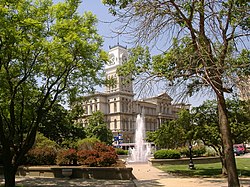Louisville City Hall
|
Louisville City Hall Complex
|
|
 |
|
| Location | Louisville, Kentucky |
|---|---|
| Coordinates | 38°15′16.43″N 85°45′38.72″W / 38.2545639°N 85.7607556°WCoordinates: 38°15′16.43″N 85°45′38.72″W / 38.2545639°N 85.7607556°W |
| Built | 1873 |
| Architect | Multiple |
| Architectural style |
Beaux Arts Second Empire Romanesque Revival |
| NRHP Reference # | 76000905 |
| Added to NRHP | September 1, 1976 |
Louisville City Hall is a registered historic building in Louisville, Kentucky, placed on the National Register of Historic Places in 1976. Completed in 1873 to house the Louisville city government, the structure is located at 601 West Jefferson Street in what became Downtown Louisville, the center of the city's civic district.
Since the merger of the former City of Louisville with Jefferson County, Kentucky, it now primarily houses the offices and chambers of the Louisville Metro Council. The former Jefferson County Courthouse, now known as Louisville Metro Hall, is now primarily home to the offices of the metro mayor of Louisville.
The site was already Louisville's civic center. The first log courthouse was built across the street in 1784, and a brick courthouse stood on the site from 1811 to 1837. Prior to the construction of the City Hall, city government officials shared space with the courthouse.
Before the City Hall's construction, there was no dedicated building for city government, whose officials used space in the county courthouses. The plan was selected by way of a design competition held in 1867 with the winner receiving $500. The contest was won in April 1867 by local architect John Andrewartha and C.S. Mergell. In late summer 1870, the final plans for City Hall construction were made by Andrewartha, who was named managing architect, and architectural firm C.L. Stancliff and Co. The remaining government buildings were demolished before ground was broken on the city hall in 1870.City engineer I.M. St. John was selected by the Lousivlle General Council to supervise the project.
Indiana Limestone, from White River quarries near Salem, Indiana was used. Construction took place between 1870 and 1873 at a final cost of $464,778. The exterior has been renovated several times but remains basically unchanged, while the interior has been completely remodeled several times.
...
Wikipedia
